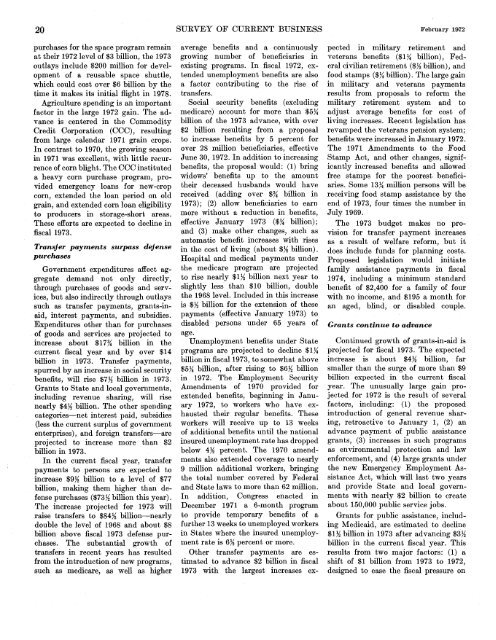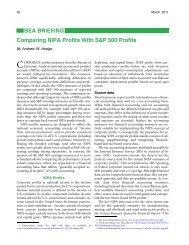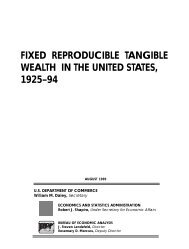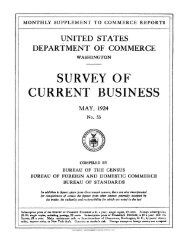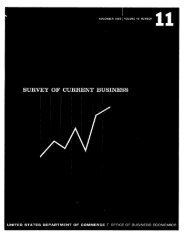current business statistics - Bureau of Economic Analysis
current business statistics - Bureau of Economic Analysis
current business statistics - Bureau of Economic Analysis
Create successful ePaper yourself
Turn your PDF publications into a flip-book with our unique Google optimized e-Paper software.
20 SURVEY OF CURRENT BUSINESS February 1972<br />
purchases for the space program remain<br />
at their 1972 level <strong>of</strong> $3 billion, the 1973<br />
outlays include $200 million for development<br />
<strong>of</strong> a reusable space shuttle,<br />
which could cost over $6 billion by the<br />
time it makes its initial flight in 1978.<br />
Agriculture spending is an important<br />
factor in the large 1972 gain. The advance<br />
is centered in the Commodity<br />
Credit Corporation (CCC), resulting<br />
from large calendar 1971 grain crops.<br />
In contrast to 1970, the growing season<br />
in 1971 was excellent, with little recurrence<br />
<strong>of</strong> corn blight. The CCC instituted<br />
a heavy corn purchase program, provided<br />
emergency loans for new-crop<br />
corn, extended the loan period on old<br />
grain, and extended corn loan eligibility<br />
to producers in storage-short areas.<br />
These efforts are expected to decline in<br />
fiscal 1973.<br />
Transjer payments surpass defense<br />
purchases<br />
Government expenditures affect aggregate<br />
demand not only directly,<br />
through purchases <strong>of</strong> goods and services,<br />
but also indirectly through outlays<br />
such as transfer payments, grants-inaid,<br />
interest payments, and subsidies.<br />
Expenditures other than for purchases<br />
<strong>of</strong> goods and services are projected to<br />
increase about $17% billion in the<br />
<strong>current</strong> fiscal year and by over $14<br />
billion in 1973. Transfer payments,<br />
spurred by an increase in social security<br />
benefits, will rise $7% billion in 1973.<br />
Grants to State and local governments,<br />
including revenue sharing, will rise<br />
nearly $4% billion. The other spending<br />
categories—net interest paid, subsidies<br />
(less the <strong>current</strong> surplus <strong>of</strong> government<br />
enterprises), and foreign transfers—are<br />
projected to increase more than $2<br />
billion in 1973.<br />
In the <strong>current</strong> fiscal year, transfer<br />
payments to persons are expected to<br />
increase $9% billion to a level <strong>of</strong> $77<br />
billion, making them higher than defense<br />
purchases ($73% billion this year).<br />
The increase projected for 1973 will<br />
raise transfers to $84% billion—nearly<br />
double the level <strong>of</strong> 1968 and about $8<br />
billion above fiscal 1973 defense purchases.<br />
The substantial growth <strong>of</strong><br />
transfers in recent years has resulted<br />
from the introduction <strong>of</strong> new programs,<br />
such as medicare, as well as higher<br />
average benefits and a continuously<br />
growing number <strong>of</strong> beneficiaries in<br />
existing programs. In fiscal 1972, extended<br />
unemployment benefits are also<br />
a factor contributing to the rise <strong>of</strong><br />
transfers.<br />
Social security benefits (excluding<br />
medicare) account for more than $5%<br />
billion <strong>of</strong> the 1973 advance, with over<br />
$2 billion resulting from a proposal<br />
to increase benefits by 5 percent for<br />
over 28 million beneficiaries, effective<br />
June 30, 1972. In addition to increasing<br />
benefits, the proposal would: (1) bring<br />
widows' benefits up to the amount<br />
their deceased husbands would have<br />
received (adding over $% billion in<br />
1973); (2) allow beneficiaries to earn<br />
more without a reduction in benefits,<br />
effective January 1973 ($% billion);<br />
and (3) make other changes, such as<br />
automatic benefit increases with rises<br />
in the cost <strong>of</strong> living (about $% billion).<br />
Hospital and medical payments under<br />
the medicare program are projected<br />
to rise nearly $1% billion next year to<br />
slightly less than $10 billion, double<br />
the 1968 level. Included in this increase<br />
is $K billion for the extension <strong>of</strong> these<br />
payments (effective January 1973) to<br />
disabled persons under 65 years <strong>of</strong><br />
age.<br />
Unemployment benefits under State<br />
programs are projected to decline $1%<br />
billion in fiscal 1973, to somewhat above<br />
$5% billion, after rising to $6% billion<br />
in 1972. The Employment Security<br />
Amendments <strong>of</strong> 1970 provided for<br />
extended benefits, beginning in January<br />
1972, to workers who have exhausted<br />
their regular benefits. These<br />
workers will receive up to 13 weeks<br />
<strong>of</strong> additional benefits until the national<br />
insured unemployment rate has dropped<br />
below 4% percent. The 1970 amendments<br />
also extended coverage to nearly<br />
9 million additional workers, bringing<br />
the total number covered by Federal<br />
and State laws to more than 62 million.<br />
In addition, Congress enacted in<br />
December 1971 a 6-month program<br />
to provide temporary benefits <strong>of</strong> a<br />
further 13 weeks to unemployed workers<br />
in States where the insured unemployment<br />
rate is 6% percent or more.<br />
Other transfer payments are estimated<br />
to advance $2 billion in fiscal<br />
1973 with the largest increases ex-<br />
pected in military retirement and<br />
veterans benefits ($1% billion), Federal<br />
civilian retirement ($% billion), and<br />
food stamps ($% billion). The large gain<br />
in military and veterans payments<br />
results from proposals to reform the<br />
military retirement system and to<br />
adjust average benefits for cost <strong>of</strong><br />
living increases. Recent legislation has<br />
revamped the veterans pension system;<br />
benefits were increased in January 1972.<br />
The 1971 Amendments to the Food<br />
Stamp Act, and other changes, significantly<br />
increased benefits and allowed<br />
free stamps for the poorest beneficiaries.<br />
Some 13% million persons will be<br />
receiving food stamp assistance by the<br />
end <strong>of</strong> 1973, four times the number in<br />
July 1969.<br />
The 1973 budget makes no provision<br />
for transfer payment increases<br />
as a result <strong>of</strong> welfare reform, but it<br />
does include funds for planning costs.<br />
Proposed legislation would initiate<br />
family assistance payments in fiscal<br />
1974, including a minimum standard<br />
benefit <strong>of</strong> $2,400 for a family <strong>of</strong> four<br />
with no income, and $195 a month for<br />
an aged, blind, or disabled couple.<br />
Grants continue to advance<br />
Continued growth <strong>of</strong> grants-in-aid is<br />
projected for fiscal 1973. The expected<br />
increase is about $4% billion, far<br />
smaller than the surge <strong>of</strong> more than $9<br />
billion expected in the <strong>current</strong> fiscal<br />
year. The unusually large gain projected<br />
for 1972 is the result <strong>of</strong> several<br />
factors, including: (1) the proposed<br />
introduction <strong>of</strong> general revenue sharing,<br />
retroactive to January 1, (2) an<br />
advance payment <strong>of</strong> public assistance<br />
grants, (3) increases in such programs<br />
as environmental protection and law<br />
enforcement, and (4) large grants under<br />
the new Emergency Employment Assistance<br />
Act, which will last two years<br />
and provide State and local governments<br />
with nearly $2 billion to create<br />
about 150,000 public service jobs.<br />
Grants for public assistance, including<br />
Medicaid, are estimated to decline<br />
$1% billion in 1973 after advancing $3%<br />
billion in the <strong>current</strong> fiscal year. This<br />
results from two major factors: (1) a<br />
shift <strong>of</strong> $1 billion from 1973 to 1972,<br />
designed to ease the fiscal pressure on


